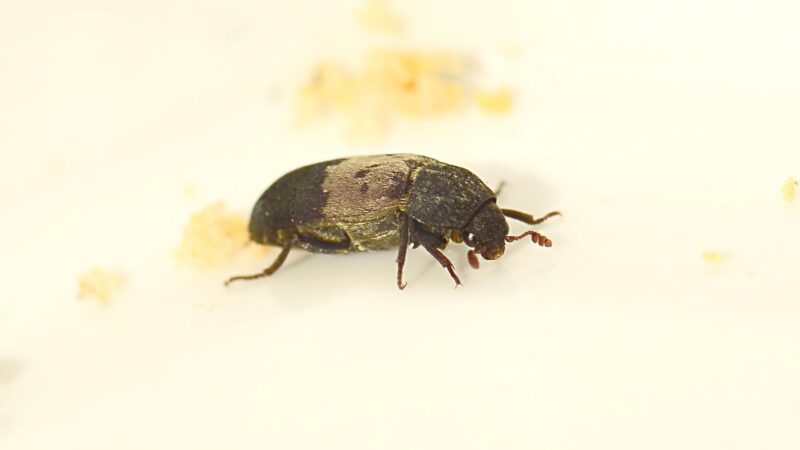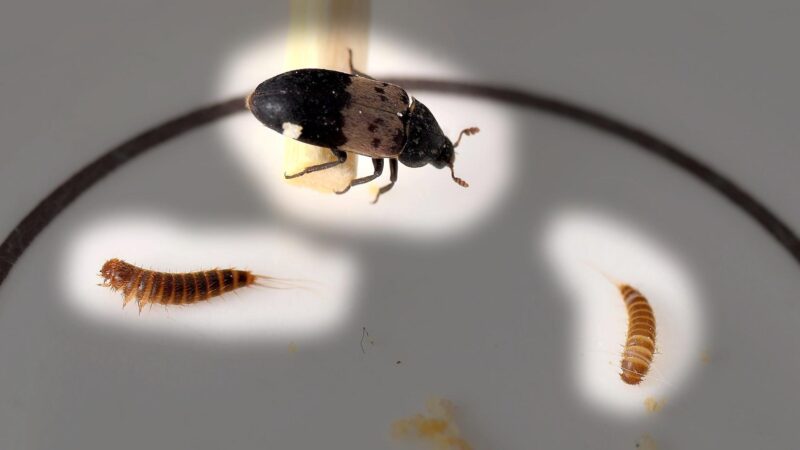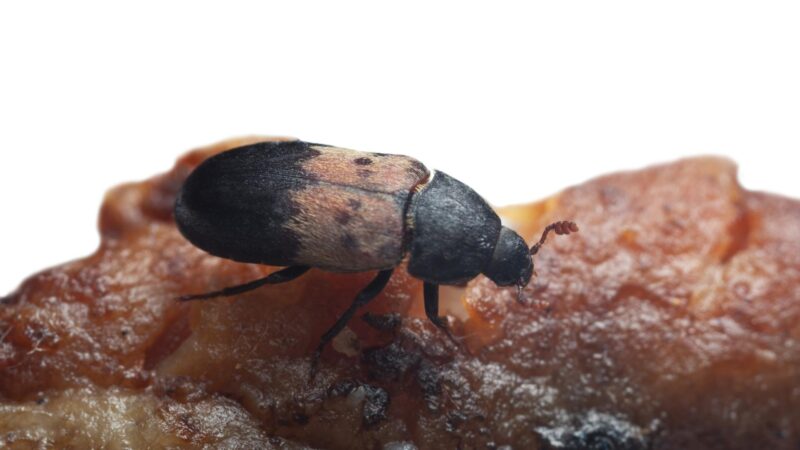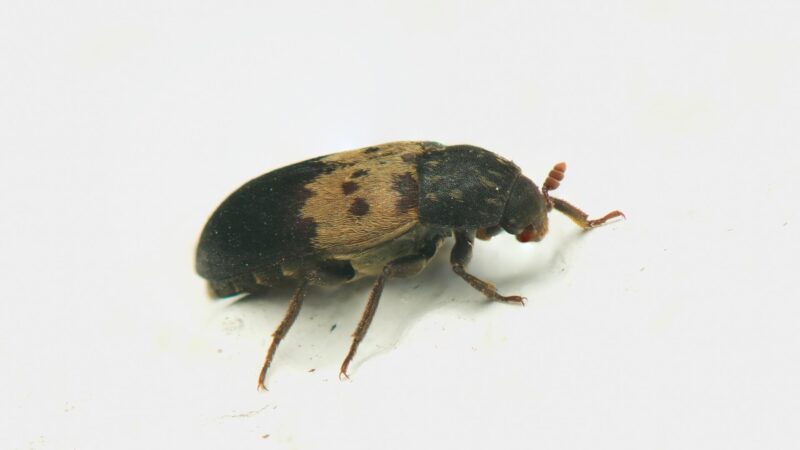Larder beetle is an unwelcome guest that loves to invite itself to pantries. During its larvae stage, it repeatedly bores holes into woods, books, and insulation items to seek protection.
What is a larder beetle? Larder beetle is a common household pest that loves to consume high-protein materials, such as dry pet food, cheese, dead animals, and even furs and feathers. This pest is approximately 1/4 to 1/3 of an inch in length and is oval-shaped with dark brown color and cream to the yellowish-colored band.
By reading this guide further, you will know more about larder beetles, like their various characteristics, identification, and ways to get rid of them. On top of that, you will have some insights into why they come to your house.
Table of Contents
What Does a Larder Beetle Look Like?

The larder beetle larvae have a worm-like appearance with deep brown to reddish color. They also have a hairy body with a couple of spines on their tails, curving backward, and they are around 1/2 of an inch in length.
Meanwhile, adult larder beetles are approximately 1/4 to 1/3 of an inch in length, having an oval-shaped body that is dark brown in color. They also have a cream to yellowish colored band found above their wing covers with six dark spots inside them.
Life Cycle of a Larder Beetle

Larder beetles undergo four stages in their lives—the egg stage, the larval stage, the pupal stage, and the adult stage. This life cycle is often called metamorphosis, which refers to the changes that happen to them.
Egg Stage
The egg stage is where the female beetles lay hundreds of eggs to be deposited into animal feces, decaying leaves, and rotten wood due to the moisture they provide.
Nonetheless, some beetles choose to keep their eggs inside them, giving birth to live larvae.
Larval Stage
At this stage, eggs have hatched and transformed into wood-boring larvae beetles. The beetle larvae have a worm-like appearance and primarily feed on the wood or timber cellulose, eating them from the inside out.
As the larvae mature, they need to shed the covering of their outer bodies, known as the exoskeleton. This shedding of the exoskeleton is called molting and can happen seven to ten times before entering the pupal stage.
Pupal Stage
The pupal stage is where the most significant change in their form happens. The grub or larvae then start to form the cacoon or pupa and stay dormant from six to 24 days before emerging as an adult.
Adult Stage
After the pupal stage, the final stage of the beetle’s life cycle will emerge, which is the adult stage. As adult beetles appear, they come in various sizes.
Larder Beetles | Identification and Habitat

The larder beetles were named after their fondness for cured meats and food pantries. They are reddish-brown in color with a colored tan band and relatively hairy bodies for the larva.
Additionally, they have a pair of wings they use to fly to pantries and areas where they can find their food. They are often found in rice mills, museums, homes, and livestock establishments, where food is abundant.
Can Larder Beetles Fly?
Larder beetles are nocturnal insects and mostly fly at dusk or dawn to look for fertile ground and continue with their life cycle.
What Do Larder Beetles Eat?
Both larvae and adult beetle like to consume high-protein materials like the following:
- Animal hide
- Dead insects and animals
- Dead skin
- Cheese
- Dry pet foods
- Dried fish
- Cured and spoiled meat
- Cake
- Hair and fur
- Fabrics and natural materials
These pests are common guests in both commercial and residential settings. They come from places where food is abundant, such as rice mills, museums, homes, and livestock establishments.
They are notorious for hitchhikers, so no wonder that you can bring some of them accidentally into your home, especially if you’re from a grocery store.
What Do Larder Beetles Dislike?
Essential oils may smell fantastic to humans, but larder beetles dislike these items a lot. With that said, you can use them to your advantage.
To do that, mix ten drops of your chosen essential oil with at least eight ounces of water and mix them thoroughly in a spray bottle. For instance, if you have chosen lavender essential oil, you can keep these bugs away by mixing ten drops of this oil with eight ounces of water.
Once done with the mixing, put the mixture in a clean spray bottle and spatter the solution into the affected areas.
Why Do I Have Larder Beetles in My House?

There are several reasons why there are some larder beetles in your home. You could have either brought them into your home unknowingly (they’re great hitchhikers), or they find your home attractive.
Larder beetles find a place attractive if other pests are present, such as cluster flies, boxelder bugs, etc., as they feed on these insects. They also feed on dead rodents, birds, and dead animals.
So, it’s best to ensure that you don’t have these elements in your home to ensure that no larder beetles can thrive in your space. If you find a larder infestation in your pantry, seek its source and remove all the infested products and other food items.
Are Larder Beetles Dangerous to Humans?
Larder beetles aren’t well-known for spreading diseases or stinging and biting humans. However, they are notorious for contaminating food products, particularly cheese and cured meats.
Are Larder Beetles Harmful to Pets?
Although adult larder beetles have the potential to bite, they’re not generally dangerous to pets. In fact, they help reduce the populations of bothersome pests, cluster flies, boxelder bugs, etc.
How to Get Rid of Larder Beetles?
Having larder beetles in your home can be a real nuisance since they usually target pantries and dry pet food. They’re also not picky eaters, which means they can eat and contaminate the food they find.
To help you with that problem, here are some ways you can get rid of larder beetles within your home:
Seal your foods well.
Sealing your food well is another way to get rid of the larder beetle. Make sure to store your rice, flour, beans, and other dry goods in well-sealed canisters, glass jars, and containers.
Deep-clean your house.
Deep cleaning is one of the best ways to ensure that no trace of larder beetles will be left in your home. Clean your home thoroughly and ensure no crumb is left so these pests won’t have something to feast on.
Use a vacuum to suck up all the crumbs that fell into your kitchen and other home areas. After that, apply your favorite cleaner and wipe all the surfaces well.
Seal the dog food well.
Dog foods and other dry pet foods are among the favorite of larder beetles. So, make sure that they are all tightly sealed in a container and leave only enough for your pets to eat.
Use commercial insecticide.
Another way to get rid of larder beetles is by using commercial insecticide. However, if you are wary of using this since it involves spraying chemicals on your food storage, you can use borax or food-grade diatomaceous earth instead.
Just put any of these powders at the corners of the affected areas, and larder beetles will eventually go away.
Seal your home from cracks.
Sealing your home from holes or cracks is another way to stop larder beetles from coming into your house. With the cracks and holes sealed, these bugs won’t have any access to your home, eliminating their existence in your personal space.
How to Get Rid of Larder Beetle Infestation?
If you want to get rid of larder bee infestation, thorough inspection and cleaning are required. After cleaning, apply a larder beetle insecticide to the back of your shelves, behind the baseboard, cracks, and gaps of your home, and seal them after.
How to Get Rid of Larder Beetle Larvae?
You can get rid of the larder beetle larvae by destroying the heavily infested food and cleaning the food storage area well. Once done with cleaning, use a household insecticide and spray it on the crevices and cracks where the insect’s pelt and debris gather.
How to Get Rid of Larder Beetles Naturally?
If you’re someone who’s against the use of chemicals or use them only as a last resort, here are some natural ways that you can use to get rid of larder beetles:
Block off food access.
Blocking the food access of these bugs can get rid of them naturally. So, ensure to keep your food securely as a top priority to keep these bugs out of your home.
Remember that they only need shelter and food to thrive, so wipe out any chances they may have to flourish in your place. Always check if the food containers are all tightly covered to ensure these bugs won’t have something to feed on to thrive.
Use essential oils.
Essential oils have always been known to deter bugs from thriving in a particular location. This is especially true if you mix two essential oils and dilute them with some water.
For instance, you can mix a few drops of peppermint oil and eucalyptus oil, then dilute it with some water. After that, shake the mixture well and start spraying it on the affected sites.
The strong smell of essential oils will stop beetles from entering your home, and rethink about coming over again.
Reduce home clutter.
Larder beetles love to spend their winter in debris around your yard and crevices of tree bark. Hence, it’s essential to reduce the organic piles and clutter around your home to give these beetles a much lesser place to stay.
Do Larder Beetles Carry Disease?
Though larder beetles are not known to carry diseases, their presence can contaminate human and pet food. So, it’s always best to ensure that all your food is sealed tightly, along with your pet’s food.
Summary
Larder beetles are among the most common pests in homes and commercial establishments. So, it’s not surprising that you may find these bugs within your property, particularly in food storage areas.
To get rid of them, consider using the given methods above to eliminate their existence in your space.